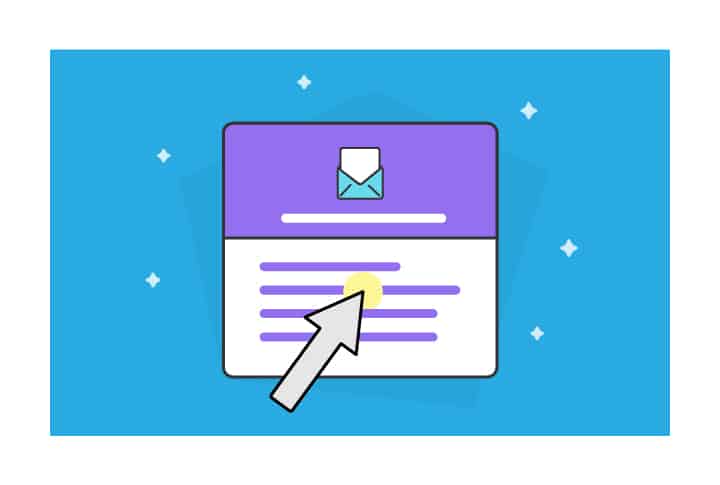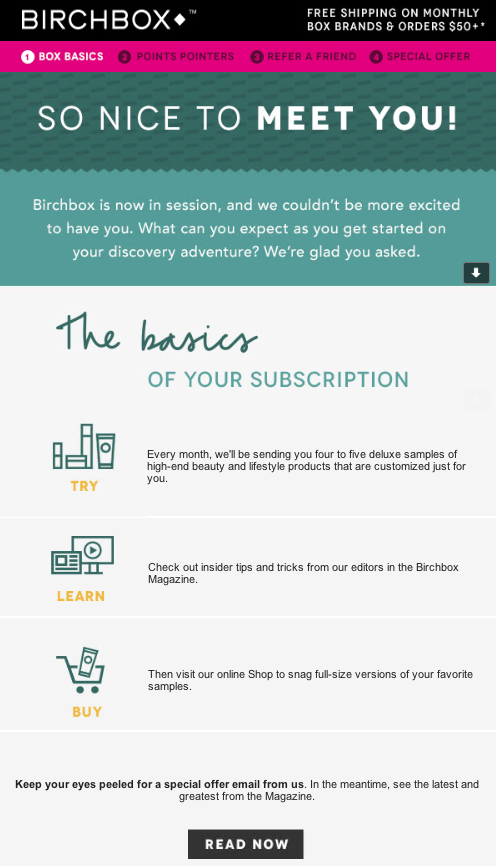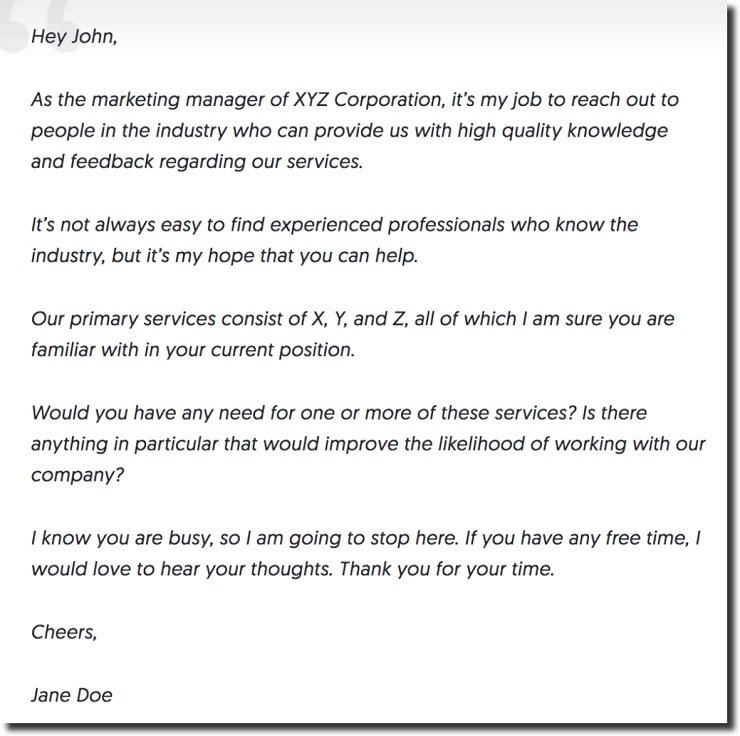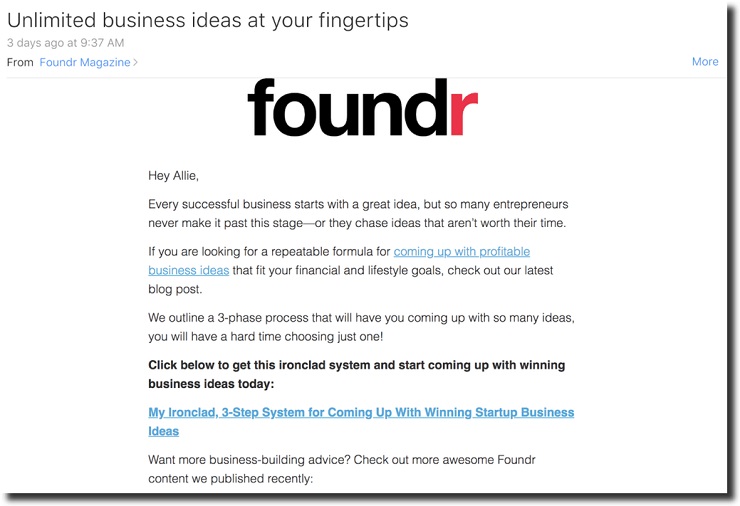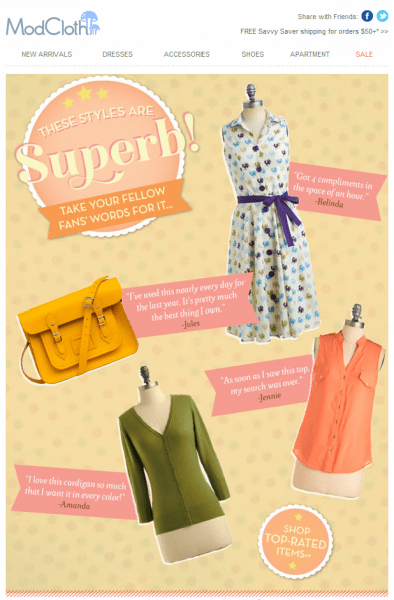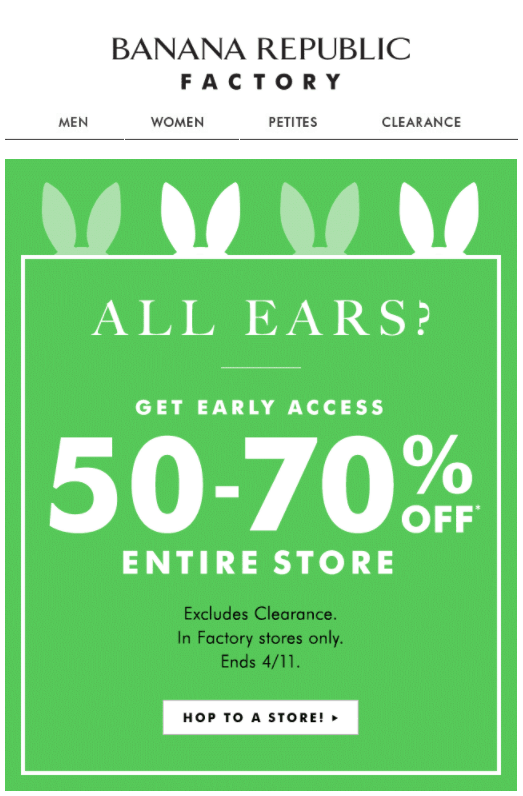Let’s say you own an ecommerce retail business and want to promote a new product via email. You don’t have the resources to drum up a major marketing campaign, but the release is too big just to include in your newsletter: It needs its own spotlight. That’s where standalone promotional emails come in, and here’s how to write one that sells.
“To open, or not to open. That is the question.”
Every day, consumers face this question in their email inboxes. They answer it in the blink of an eye, sometimes hundreds of times a day. If you’re doing email marketing, it’s your job to lead them to the desirable answer.
As the competition in online marketing grows, this is only getting tougher.
But a high open rate isn’t the only thing your business is fighting for. You also need clicks, and ultimately, sales. And sometimes, you only have one shot, one email, to pull it all off!
This article will not only break down how to write that successful sales email, but it will also equip you with a few copywriting best practices so that every email you send is capable of making a sale.
But first, in the video below, Google employee turned multimillion-dollar entrepreneur and instructor of our 7-Figure Copywriting course Arman Assadi discusses nine tips for writing email copy that sells.
FREE Masterclass: The Genius “10-Step Copywriting Framework” Behind 11 Different 7-Figure Launches
Email Copywriting: Email Campaigns vs. Sales Emails
An email is an email is an email, right? Not quite. Good email marketing is nuanced, with each type of email carrying its own purpose.
In this case, we want to draw a distinction between email marketing campaigns and standalone emails. While they’re both promotional and use some of the same strategies, they’re also very different.
An email marketing campaign is a series of emails that build awareness of a specific happening: a product release, a major rebranding, an event, or the like. They typically include anywhere from three to seven emails that slowly release information and build buzz. But not all of the emails will attempt to make a sale, and some will intentionally leave out crucial information.
Standalone promotional (or sales) emails share a similar goal in that they aim to entice a purchase or engagement. But their purpose may not warrant an entire campaign of messages. You may not have the resources to run an entire campaign or you may just be running a seasonal promotion and want to send one email to see how well it performs.
That means they only have one chance to close the deal.
Promotional emails must be value-packed and deliver that killer combo of crucial information paired with persuasive copy and easy-to-digest design. Let’s dive into some elements of successful sales emails.
Anatomy of a Great Sales Email
When it comes to promotional emails, a few elements contribute to success: length, style, and promotional approach. Below, we’ll discuss each element and which version might be best for your emails—and your customers.
Email Length: Long vs. Short
Ah, the constant battle of how much to write in each email. With a product release or announcement, it’d be easy to write paragraph after paragraph of detailed information. But these days, people aren’t interested in spending a lot of time in their inboxes reading. At the end of the day, content length all comes down to what your audience best responds to.
Long Emails
Benefits
- Long emails allow plenty of room for hyperlinks, calls-to-action, and lots of information.
- Long emails give you a chance to guide each reader through the sales funnel, so by the time they get to the end (if they make it) they know whether or not they want to buy
Drawbacks
- Readers don’t usually want to read long, scrolling copy and will likely skim, missing important information.
- Long emails don’t drum up as much curiosity or buzz, since all the information is in one place, potentially discouraging a click-through.
Short Emails
Benefits
- Short emails build curiosity and get to the heart of the matter right away, meaning customers will know exactly what’s asked of them.
- Short emails force you to use only the most important information and most strategic hyperlinks and calls-to-action, weeding out any fluff or extra information that might distract readers.
Drawbacks
- Short emails might not be enough to build trust or a connection with your audience.
- Readers might have specific reservations or questions that you didn’t address in the short email copy.
Which one is best? Take a look at your other marketing and advertising. How long are your social media posts and captions? How about your print advertising? What do your product descriptions and web pages look like? Mimic this length in your emails and see how your audience responds. You can always tweak as you go.
FREE Masterclass: The Genius “10-Step Copywriting Framework” Behind 11 Different 7-Figure Launches
Email Style: Text vs. Graphical
Visual content marketing is an ever-increasing phenomenon among content creators and digital marketers. Historically, email has been a text-heavy medium with a few images sprinkled in. Now, marketers often include infographics, illustrated data, and embedded videos to share information with their audiences.
For reference, here’s an example of a design-centric email:
Text Emails
Text emails are exactly what you would expect, all text with no graphics.
Pros
- Text-based emails provide your readers with the exact information they need.
- Text-based emails typically come through on all servers, meaning your readers won’t potentially see jumbled text or image errors.
Cons
- Text-based emails can be boring and fall short on engagement or excitement.
- Some information in a text-based email may be easier to consume in a graphical format, such as the results of a study or an important call-to-action.
Graphical Emails
Pros
- Graphical emails are fun! They allow you to extend your branding into your readers’ inboxes and make your information easy to read and understand.
- Depending on your audience, graphical emails might be read by more people since they’re considered “less work.”
Cons
- Graphical emails might be easy to read, but they take more time to design and create.
- Graphical emails could have problems downloading correctly on your readers’ servers, jumbling the design you worked so hard to create.
Which one is best? If you’re just starting out and have a fixed budget, try text-based emails first. Once you grow, work with a designer to create graphical emails and split test them to see which ones your audience prefers.
You may think that text-based emails would always perform worse than graphical emails, but this is not always the case. Some people prefer the ease and simplicity of text-based emails. Text can also have more of a grassroots, personal feel that could work well with your brand.
Email Promotional Approach: Hard Sell vs. Soft Sell
Some consumers appreciate a direct selling approach that basically demands a purchase. Others respond better to a soft sell––one that leads with benefits and aims to put each customer at ease. Whether you approach your promotional email with a hard sell or soft sell will depend on your customer preference, email goals, and overall brand voice guidelines.
To compare, here’s a hard sell email next to a soft sell as shown on Neil Patel’s blog (hard sell on the left):
Hard Sell
Pros
- A hard sell guarantees your readers will know exactly what you’re promoting and what you’d like them to do—buy, subscribe, attend, etc.
- A hard sell can help indecisive customers and garner more sales from impulsive consumers.
Cons
- Hard sells can be considered aggressive and might turn away consumers who aren’t quick to trust.
- Hard sells aren’t a good long-term strategy, as repeat customers and word-of-mouth are very important for sales and hard sells don’t tend to build rapport with customers.
Soft Sell
Pros
- Soft sells build trust with customers, especially when you provide money-back guarantees and free trial periods.
- Soft sells allow you to build rapport and create word-of-mouth buzz around your products or services.
Cons
- Soft sells may not be enough for indecisive customers or provide a big enough push for a standalone promotional email.
- A soft sell may need a little more work in terms of email copywriting and design, since the sale itself needs to be more subtle
Which one is best? If your brand was a person, and you spoke to him or her face-to-face, what personality would you encounter? The question of hard vs. soft sell comes down to the character of your brand as a whole. Keep that brand voice consistent in your promotional emails, and leave room for subtle changes as you promote different products or content.
Now that you know which elements of a promotional email might work best for your email efforts, let’s dive into how to write a compelling sales email.
Email Copywriting Best Practices
The copy in your promotional emails can determine the success of its open rate and click-through rate. There are certain best practices that every email marketer should follow.
Regardless of what you’re selling, how long your email is, and how you’re approaching the sale, you should always start with a defined target audience. Once you know that, you’ll be able to write your email in a way that attracts and engages them to take action.
1. Don’t Neglect the Subject Line
First impressions are important, and the same goes for your email. Your email subject line is prime real estate. It alone will determine whether one-third of your audience opens your email, and will heavily influence your other readers’ decisions.
Your subject line can also encourage another decision: whether or not to report your email as spam. Almost 70% of recipients will decide to report an email based on the subject line alone.
That’s why you can’t neglect your subject line—it stands to determine the success of your overall email.
Compelling subject lines that encourage opens use strong action verbs and leverage basic human desires (like money, power, health, popularity, etc.). Why would your audience want to open your email and purchase your product or read your content? Put your strongest value proposition in your subject line, and let curiosity do its work.
The Ladders is an online resource for job-seekers. Their email subject line is successful because it leverages the basic human desire of success and status (through getting a job by being prepared for an interview). It also promises to deliver content you might not find anywhere else: “…questions you’re not ready for.”
A few other amazing, real subject lines we’ve seen:
- Copyblogger: “How to Calm Your Content Anxiety in 5 Simple Steps”
- PayPal: “Last days! Enter for a chance to win a $10k getaway”
- Macy’s: “Psst – it’s our Private Shopping Event & you’re invited”
Reminder: Always ensure your email copy is aligned with your subject line. Don’t promise your audience one thing and deliver another.
2. Stay In Your Vertical
We’ve discussed the importance of designing and organizing your sales email based on your target audience. Well, the same goes for writing your email. In order to capture the most opens and click-throughs, you must cater your email copywriting to your audience.
If you market to college students, you should write your email as if you’re speaking to a room full of 20-somethings. If your business serves professionals and executives, your email should reflect a business-like tone.
Check out this (hilarious) promotional email from Chubbies. This copy, albeit untraditional compared to other, more straightforward promotions, reflects exactly how their target audience, millennials, communicates.
Your email copy should also resemble a conversation, whether with a young or old, casual or professional person. The key to quality content, whether on your blog, social media, or email, is to create a one-on-one experience for your reader.
Speak directly and authentically to them in your email copy, and your audience will be more likely to tap that “Buy Now” or “Read More” button.
Foundr’s emails are a classic example of using clear, conversational copy when promoting a course or piece of content. Could we make these emails more “sales-y?” Sure. But that’s not really how the brand works. We’ve always interacted with our audience the way we would our peers, or even our friends. So we keep our emails pretty chill. And pretty short, which we arrived at through A/B testing.
3. Present Hard Numbers and Real Stories
Standalone promotional emails essentially have one shot at making a sale (or bringing about another desired action). That means you have to include valuable, relevant data that establishes authority and shows your audience that your brand and product or service offering is trustworthy.
Let’s say you’re a ecommerce jewelry company promoting a product that’s been flying off your (digital) shelves. For example, it’s not quite enough to say, “This product sells like wildfire!” Instead, present real numbers, such as, “We sold over 500 of these necklaces within the first after the launch. Grab one before they’re gone!”
This is a classic case of social proof, and the more specific you get, the more the phenomenon can work in your favor.
The same goes for testimonials and stories. Consumers love reading authentic reviews and typically make purchase decisions based on testimonials and word-of-mouth alone. Including a limited number (don’t overload them) can be helpful.
Take a look at this promotional email from ModCloth, an online clothing retailer targeting women. Not only are they promoting some favorite styles using testimonials alone, but the testimonials are clearly authentic—they’re concise, specific, and enthusiastic. Had ModCloth simply said, “I love this shirt!” their readership would’ve seen right through it.
4. Get To The Point
Whether you opt for a long email or stick with the short, sweet text, it’s always crucial to get to the point of your email. In order to retain as much of your audience’s attention as possible, keep your email body content relevant to the purpose of the promotion. Avoid hopping around, and especially don’t try to meet multiple goals through the single email.
For example, let’s say you’re promoting a new course that your company just created. You might be tempted to also mention your company’s new blog that’s all about the topic from the course. The blog is relevant to the overall promotion, right? Yes, but by mentioning it, you’re inherently asking for your audience to do multiple things: purchase your new course and subscribe to your new blog.
That’s one too many things to include in your email. When it comes to standalone promotional emails, get to the point and stick to it. Make sure that all of the key elements support that one point. It should never be unclear what you want your readers to do. Concentrating your content will help your readers stay on track and better your chances of seeing a click-through.
5. Don’t Forget Your Call-to-Action
Speaking of click-through…
Don’t forget to include the element you’d like your audience to click on. You’d be surprised at how common this is: Marketers get so caught up in the copy (which is important, don’t get me wrong) that they forget to include a clear call-to-action at the end—which essentially turns your promotional email into a casual note to your audience.
Your call-to-action could be hyperlinked text or it could be a big, bright button. Regardless, your CTA should be clear and connected to the rest of your email. If you’re promoting a product, make your CTA something like “Buy Now” or “Add to Cart.” If you’re alerting your audience to a sale or discount, say “Claim Offer” or “Save Now.”
Avoid generic calls-to-action like “Learn More” or “Check It Out.” This essentially tells your audience that there’s more work and reading on the other side of that button. Keep your CTA concise and aligned with your overall promotion.
FREE Masterclass: The Genius “10-Step Copywriting Framework” Behind 11 Different 7-Figure Launches
Now Go Write Some Killer Emails
Standalone promotional emails put a spotlight on a single offer, tailored to your audience, and promoted with hard numbers and real stories. In order to boost your open and click-through rates on these marketing emails, they should be written strategically with sound email copywriting techniques—similar to any other promotional content but with an extra one-two punch that communicates value and urgency. Craft your proverbial spotlight correctly, and your promotional emails will see levels of engagement better than before.
What copywriting or design techniques have you used to help your own open and engagement rates? Share with us in the comments below!
